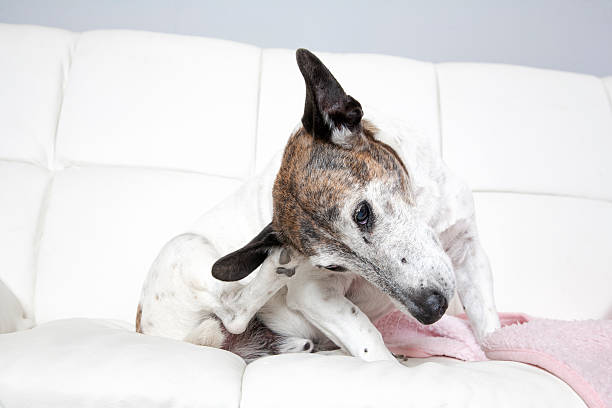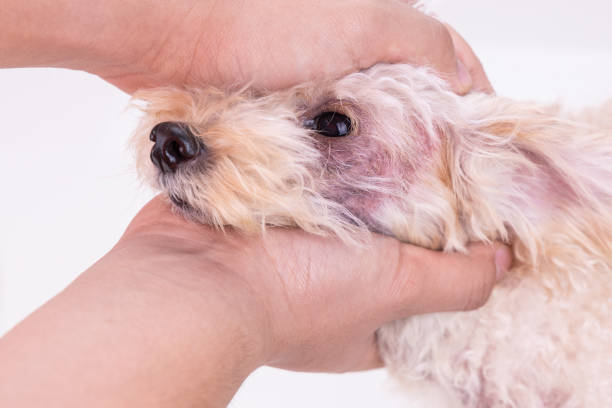Many dogs, from various age groups, particularly at certain times of the year, suffer from anxiety triggered by loud sounds. As November arrives, the constant fireworks can trigger your dog to find a safe haven under what you deem as your bomb shelter – your bed.
Come Christmas, nervous dogs may become increasingly anxious around extended family members they don’t know: Granddad’s gin-fuelled dancing scares dogs too. Many dogs run from the vacuum cleaner, but for some, it’s a real problem. Sometimes it is easy to forget that a dog’s hearing is far more sensitive than ours; if it wasn’t, there’d be no such thing as dog whistles!
Related read: Dogs and Depression


Common Noises Dogs Fear
Some of the most common noises that trigger anxiety in dogs are thunderstorms, fireworks, Bonfire Night, hoovering, sirens, construction noises, gunshots, new people, or anything else that is loud, unknown, and unfamiliar.
Symptoms the Noise May be Too Much for Your Dog
The common signs and symptoms that a dog suffers from noise-based anxiety are: barking, chewing, digging, dilated pupils, drooling, flatulence, hiding, pacing, panting, trembling, trying to escape, and urinating or defecating.
In some cases, anxiety can even lead to aggression in dogs. It is important not to leave your dog alone when they are likely to have an anxiety attack (such as Halloween, Bonfire Night, and New Year’s Eve) as they may hurt themselves in their panic.
In an infamous case reported by Katherine A. Houpt, VMD, Ph.D., a dog managed to escape from its owner’s house only to be hit by traffic.


Simple Things You Can Do to Ease Your Dog’s Anxiety
- Give them refuge: If your dog has a safe place they like to retreat to during times of distress (like under the bed) then let them. If they feel safe and secure don’t try to move them or entice them out, it may only worsen their discomfort. Instead, let them come out when they are ready and praise them when they do.
- Don’t panic: When your dog has an anxiety attack it is important that you, as their owner remain calm, positive, and happy. If your emotions are negative, your dog may end up feeding off your emotions and worsening their condition.
- It’s not the dog’s fault: To that end, you should not punish your dog when it is anxious or upset; it will only work to make it more subservient to calm you down.
- Try not to ‘over comfort’: That being said, nor should you overly comfort your dog at these times, the reason being that over time it may become a conditioned response to expect comfort during times of fear.
- Give veterinary strength herbal medicines a go: Dorwest Scullcap & Valerian Tablets, which is a licensed herbal medicine that provides symptomatic relief from anxiety and nervousness. As a herbal combination, it comes in a sugar-coated tablet that helps excitability and travel sickness.
- Try a plug-in solution – DAP or Feliway: Instead of training, you may want another treatment such as Dog Appeasing Pheromones (DAPs for cats), specifically designed to calm dogs that suffer from anxiety. Most forms of DAP products come in spray or plug-in spray form which douses your dog’s environment with calming pheromones we can’t smell.
- Steer clear of prescribed relaxants if you can: Your vet can prescribe a tranquiliser as a treatment for anxious dogs. Unfortunately, most of these drugs aren’t effective at treating anxiety but just sedate the dog. All it means is that your dog can still hear loud noises but cannot physically react. Long-term use could also have side effects, which can be detrimental to your dog’s long-term health, so it’s best to steer clear if you can.
New family members can also cause anxiety. Find out here: How To Introduce A New Dog To Your Pack
- Give anxiety training a go: It is possible to treat your dog’s anxiety with the right training. There’s a technique known as ‘Habituation’, which is widely used among nervous dog owners. Habituation is a process where you gradually train your dog to become used to their anxiety triggers through gentle exposure and positive reinforcement.
- Use positive reinforcement: The most common method is to use a CD recording of what triggers anxiety in your dog (e.g. a CD of fireworks going off). First, you play the CD at the lowest possible sound so that your dog notices the noise but does not take another action. Then you use positive reinforcement (a cuddle, or a good play) so they learn to associate the noise with something positive.
Gradually you turn up the noise bit by bit while still using positive reinforcement until the noise no longer bothers them. If your dog becomes upset by the noise at any point, turn it down to a comfortable level and try again. This method may require a weekly ‘dose’ of exposure for the rest of your dog’s life for effective and lasting treatment, but what’re five minutes on a CD compared to days of fear and anxiety.
Remember that each dog is different and what works for some may not work for others.


